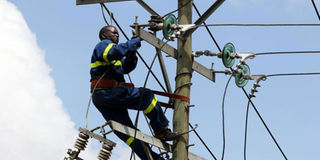Ketraco defends value for Sh200bn power lines amid delays

A Kenya power technician at work in Nairobi. FILE PHOTO | NMG
What you need to know:
- Value of the high-voltage power lines will be felt in the next four years, says firm
- About 4,000 kilometres of modern power lines will have been switched on by 2022,
The Kenya Electricity Transmission Company (Ketraco) says the value of the more than Sh200 billion committed to high-voltage power lines will be felt in the next four years amid growing concerns over costly project delays.
Ongoing modernisation of electricity transmission cables, albeit at a sluggish pace, will put the country in a strong position to attract global industrial giants, the national electricity transmission system says.
This will be in line with the manufacturing pillar under the Big Four Agenda – which also includes food security, affordable housing and universal healthcare – in President Uhuru Kenyatta’s legacy term which has about four years to run.
“For you to encourage big manufacturing firms such as steel mills to set up, they need to be assured of reliable and stable power.
"That assurance can only be achieved by having a national grid that is stable,” Ketraco chief executive Fernandes Barasa told the Smart Company.
“Ketraco comes in as an enabler to provide a reliable and stable national grid, which basically is achieved by constructing high-voltage transmission lines. Large steel manufacturers will now afford to come and set up their factories in Kenya especially in areas where the line is 400 kilovolt (kV).”
4,000km power lines
About 4,000 kilometres of modern power lines will have been switched on by 2022, he said, adding this will improve reliability of electricity supply – a key attraction for energy intensive industries such as those in steel, machinery and chemical manufacturers.
“Once done, they will be a game changer. Issues about reliability will be a thing of the past and we will be discussing about demand because infrastructure will be there,” the Ketraco chief said.
“I normally refer to energy projects as reverse-economics where you provide infrastructure and then demand is dictated by supply. You supply infrastructure and then demand will definitely be created because investors want to see infrastructure being created and that’s when they can be encouraged to set up factories.”
Kenya has an installed capacity of 2,336 megawatts (MW) against a peak demand of 1,770MW (as of last January), statistics from Electricity Regulatory Commission (ERC) showed earlier in the year, leaving a reserve capacity 566MW.
The reserve is tapped during emergency situations such as when several electricity plants are taken off the national grid for maintenance or breakdowns.
Implementation of the high-voltage projects of 132kV, 220kV and 400kV capacity has, however, been marred by lengthy delays which have seen taxpayers slapped with hefty penalties for idle capacity in cases where private developers are involved.
Court cases
The challenges range from high compensation fees for way leaves, which sometimes end up in court, to delayed cash disbursements by the Treasury due to competing priority funding areas, Mr Barasa said.
“One of the biggest challenge is wayleave acquisition where landowners are demanding exorbitant compensations as much as 10 times more than the market value,” he said.
The agency, he said, has come up with a plan where it seeks to sign agreements with claimants to stagger compensation, a strategy he says is working for the 60-kilometre, 132kV Eldoret-kitale line.
Costly delays have, however, been experienced on the 428-kilometre, 400kV Loyiangalani-Suswa line meant to evacuate power from the 300MW Lake Turkana wind farm in Marsabit at a cost of Sh5.7 billion.
Any further delays on the project – whose initial contractor Grupo Isolux Corsan of Spain was declared insolvent in August 2017 – beyond August will see taxpayers pay additional Sh1 billion monthly for idle capacity, cash which will be recovered from electricity bills to households and businesses.
The only high-voltage project completed is the 400kV Suswa-Isinya-Rabai transmission line, commonly referred to as the Nairobi-Mombasa line, which was commissioned by President Kenyatta last August, enabling evacuation of cheaper geothermal power from Naivasha to Mombasa.
The 480-kilometre project, initially designed as 200Kv line before being revised, faced delays since construction started in August 2011 at an initial budget of $140 million (Sh14.22 billion under current exchange rates).
Green energy
However, the energy regulator says the Lake Turkana Wind Power project is expected to be connected to the national grid by September this year following hand over to a Chinese contractor to set up the remaining section of high voltage wires for evacuation of the green energy.
According to the Energy Regulatory Commission Director General Pavel Oimeke, delays of the project are attributed to challenges that faced Spanish companies forcing the government to resort to another contractor who has committed to complete the project within the next three months.




